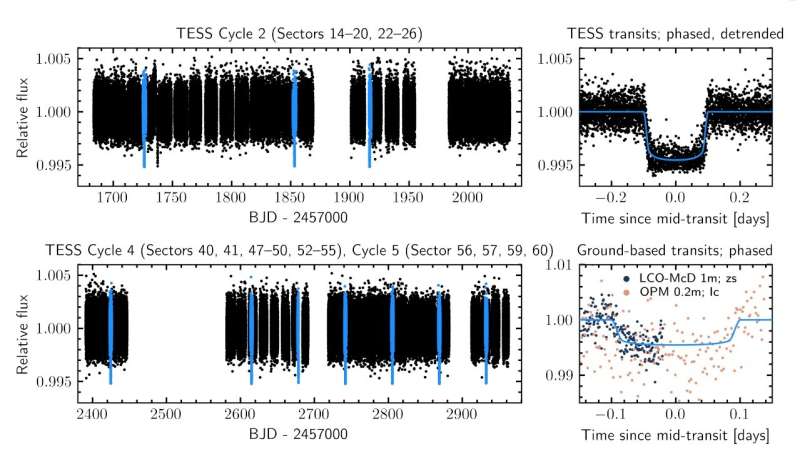June 6, 2023 report
This article has been reviewed according to Science X's editorial process and policies. Editors have highlighted the following attributes while ensuring the content's credibility:
fact-checked
preprint
trusted source
proofread
Astronomers discover a new 'warm Jupiter' on an eccentric and misaligned orbit

Using NASA's Transiting Exoplanet Survey Satellite (TESS), astronomers have discovered a new "warm Jupiter" exoplanet. The newfound alien world, designated TOI-1859 b, orbits its parent star on an eccentric and misaligned orbit. The finding is reported in a paper published May 25 on the arXiv preprint server.
TESS spacecraft is conducting a survey of about 200,000 of the brightest stars near the sun with the aim of searching for transiting exoplanets. So far, it has identified nearly 6,600 candidate exoplanets (TESS Objects of Interest, or TOI), of which 333 have been confirmed so far.
Now, a team of astronomers led by Jiayin Dong of the Pennsylvania State University (PSU), reports another confirmed TOI. According to the recently published paper, a transit signal has been identified in the light curve of a late-F dwarf star known as TOI-1859 (other designation TIC-229742722). The planetary nature of this signal was confirmed by follow-up ground-based observations.
"As a continuous-viewing-zone target, TOI-1859 has been observed in more than 20 TESS sectors over the span of four years. The TESS Cycle 2 observations from Sectors 14–20 and 22–26 (UT 2019-Jul-18 to UT 2020-Jul-04) lead to the initial detection of planetary transit signals," the researchers wrote in the paper.
The newly detected planet TOI-1859 b has a radius of about 0.86 Jupiter radii and orbits its host every 63.48 days, at a distance of some 0.33 AU from it. Given that the parent star has an effective temperature of approximately 6,341 K, the size and the separation of TOI-1859 b from the star suggests that it is a "warm Jupiter."
The observations found that the sky-projected stellar obliquity for TOI-1859 b is at a level of 38.9 degrees and the orbital eccentricity turned out to be about 0.57. The astronomers suppose that such an eccentric and misaligned orbit of TOI-1859 b is likely due to dynamical interactions, like planet-planet scattering and planet-disk resonance crossing.
The authors of the paper propose further investigation of the TOI-1859 system in order to verify the origin of the planet's peculiar orbit. They suggest that long-term radial velocity follow-up measurements are needed in order to detect any other planetary/brown dwarf candidates and constrain their masses and orbit.
Furthermore, the researchers noted that more studies of warm Jupiters like TOI-1859 b are required to check whether or not the effective temperature of a star influences the orbital alignment.
"Detecting and characterizing more warm Jupiter systems like TOI-1859b around both cool and hot stars will fill out the parameter space and reveal any possible trends between host star effective temperature and stellar obliquity in warm Jupiter systems," the scientists concluded.
When it comes to the properties of the host star, the observations show that it is a metal-rich F dwarf about 30% larger and more massive than the sun.
More information: Jiayin Dong et al, TOI-1859b: A 64-Day Warm Jupiter on an Eccentric and Misaligned Orbit, arXiv (2023). DOI: 10.48550/arxiv.2305.16495
Journal information: arXiv
© 2023 Science X Network

















